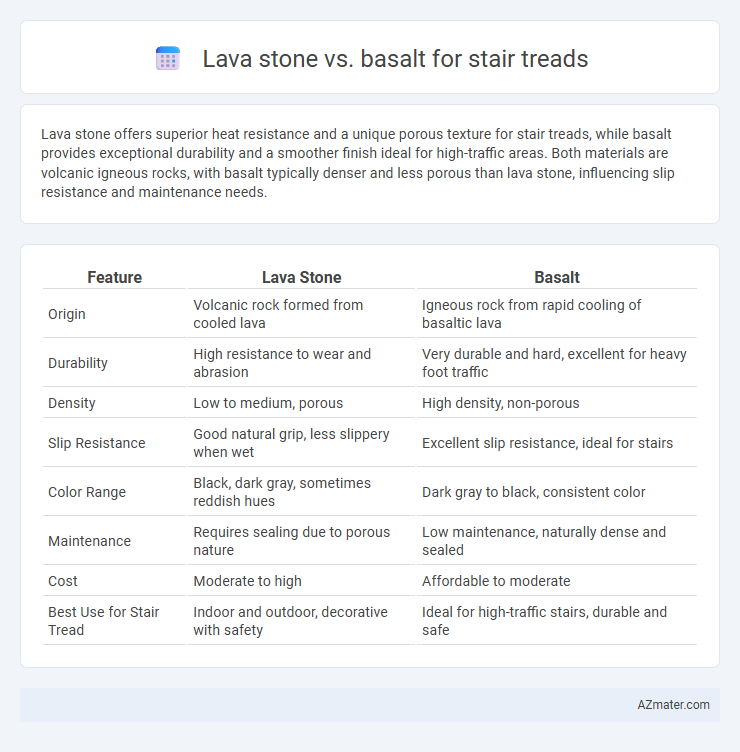Lava stone offers superior heat resistance and a unique porous texture for stair treads, while basalt provides exceptional durability and a smoother finish ideal for high-traffic areas. Both materials are volcanic igneous rocks, with basalt typically denser and less porous than lava stone, influencing slip resistance and maintenance needs.
Table of Comparison
| Feature | Lava Stone | Basalt |
|---|---|---|
| Origin | Volcanic rock formed from cooled lava | Igneous rock from rapid cooling of basaltic lava |
| Durability | High resistance to wear and abrasion | Very durable and hard, excellent for heavy foot traffic |
| Density | Low to medium, porous | High density, non-porous |
| Slip Resistance | Good natural grip, less slippery when wet | Excellent slip resistance, ideal for stairs |
| Color Range | Black, dark gray, sometimes reddish hues | Dark gray to black, consistent color |
| Maintenance | Requires sealing due to porous nature | Low maintenance, naturally dense and sealed |
| Cost | Moderate to high | Affordable to moderate |
| Best Use for Stair Tread | Indoor and outdoor, decorative with safety | Ideal for high-traffic stairs, durable and safe |
Introduction to Lava Stone and Basalt
Lava stone and basalt are volcanic igneous rocks commonly used for stair treads due to their durability and aesthetic appeal. Lava stone is porous and lightweight with a rough texture, providing excellent slip resistance, while basalt is dense, hard, and fine-grained, offering superior strength and a smooth, polished finish. Both materials withstand heavy foot traffic, but lava stone's unique vesicular surface contrasts with basalt's uniform solidity, influencing design and performance in stair construction.
Geological Origins: How Lava Stone and Basalt Form
Lava stone and basalt both originate from volcanic activity, with lava stone being the solidified molten rock expelled during volcanic eruptions. Basalt forms through the rapid cooling and solidification of lava at the Earth's surface, characterized by fine-grained texture due to its quick crystallization. The geological processes contributing to their formation impact their density, durability, and suitability for stair treads in construction.
Physical Properties Comparison
Lava stone and basalt exhibit distinct physical properties crucial for stair tread applications. Lava stone is porous and lightweight with moderate hardness, providing good thermal insulation but lower abrasion resistance compared to basalt. Basalt boasts higher density, exceptional durability, and superior compressive strength, making it more resistant to wear and ideal for high-traffic stair treads requiring long-lasting performance.
Aesthetic Differences and Visual Appeal
Lava stone stair treads present a porous, textured surface with rich, earthy tones that enhance rustic and natural design themes. Basalt stair treads feature a denser, smoother finish with deep black to dark gray hues that deliver a sleek, modern aesthetic. The contrast in texture and color between lava stone's rugged appearance and basalt's refined elegance significantly influences the visual appeal of staircases in architectural spaces.
Durability and Strength Analysis
Lava stone and basalt are both highly durable materials commonly used for stair treads, with basalt exhibiting higher compressive strength typically ranging from 100 to 300 MPa compared to lava stone's 90 to 200 MPa. Basalt's dense, fine-grained structure provides superior resistance to abrasion and impact, making it ideal for high-traffic areas, while lava stone offers robust durability with natural thermal resistance. Both stones maintain excellent weathering properties, but basalt generally outperforms lava stone in terms of long-term structural integrity for stair tread applications.
Slip Resistance and Safety Features
Lava stone offers excellent slip resistance due to its naturally porous and rough texture, making it a safe choice for stair treads in both indoor and outdoor environments. Basalt, although dense and durable, tends to have a smoother surface that may require additional treatments like anti-slip coatings to enhance safety. The natural slip-resistant properties of lava stone reduce the risk of falls, making it a preferred material for stair treads where safety and traction are critical.
Weather and Chemical Resistance
Lava stone stair treads exhibit exceptional weather resistance due to their porous structure, allowing for excellent thermal insulation and durability in varying climates. Basalt offers superior chemical resistance, making it highly resistant to acids, alkalis, and salt, ideal for environments exposed to harsh chemicals or de-icing agents. Both materials maintain their structural integrity under extreme weather conditions, but basalt's denser composition provides enhanced protection against chemical degradation.
Installation Process and Maintenance
Lava stone stair treads offer a straightforward installation process due to their uniform texture and lightweight properties, allowing easier cutting and fitting compared to basalt. Basalt requires specialized tools for precise cutting and anchoring due to its denser composition, resulting in a more labor-intensive installation. Maintenance for lava stone is minimal, with its porous nature benefiting from regular sealing, while basalt's natural density provides superior resistance to moisture and staining, reducing the frequency of upkeep.
Cost Evaluation: Lava Stone vs Basalt
Lava stone generally costs more than basalt due to its rarity and unique porous texture, which requires specialized processing for stair treads. Basalt offers a more cost-effective option with durable properties and easier availability, making it popular for budget-conscious projects. Evaluating installation and maintenance costs, basalt tends to minimize long-term expenses due to its lower porosity and higher resistance to wear.
Best Applications for Stair Treads
Lava stone and basalt are both durable volcanic rocks ideal for stair treads, with basalt offering superior hardness and resistance to wear, making it the best choice for high-traffic areas. Lava stone's lightweight and porous texture provides excellent slip resistance, suitable for outdoor or wet environments where safety is a priority. For stair treads, basalt's dense structure enhances longevity and load-bearing capacity, while lava stone's natural thermal insulation benefits steps exposed to fluctuating temperatures.

Infographic: Lava stone vs Basalt for Stair tread
 azmater.com
azmater.com